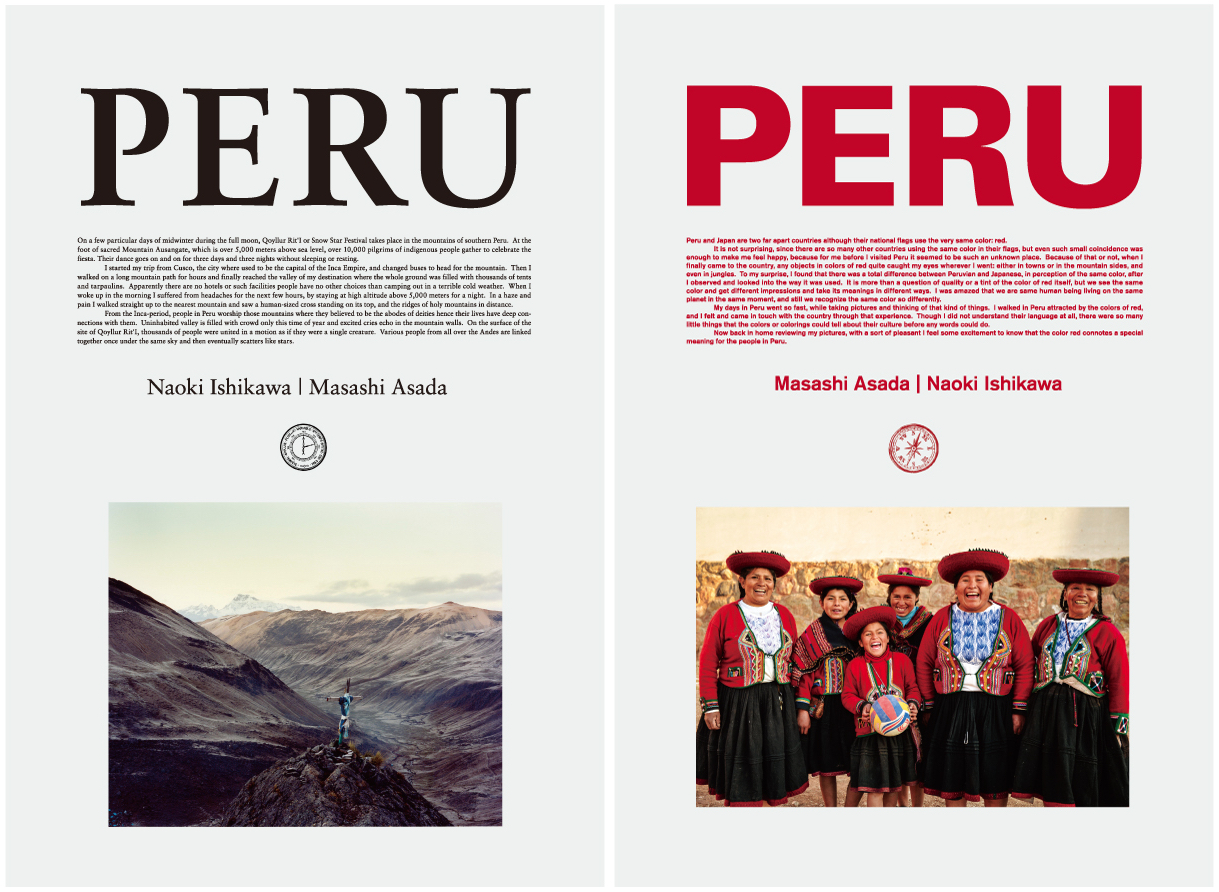PUNCTUM TIMES No. 17
石川直樹 × 浅田政志『ペルー』
Naoki Ishikawa x Masashi Asada “PERU”
プンクトゥム・タイムズ第17号は、石川直樹、浅田政志両氏の写真家によるコラボレーション写真集『PERU』です。
南米大陸のほぼ中央に位置するペルー共和国は、紀元前から古代文明が栄え、インカ帝国の中心地でした。その後スペインに征服され植民地となりますが、1821年に独立し共和国に。国土は、熱帯雨林、山岳地域、海岸砂漠地域の3つのエリアに分けられます。バルガス=リョサ(小説家)や、南米初の日系大統領アルベルト・フジモリなど、日本にもなじみのある国のひとつかもしれません。
日本の人気若手写真家の二人がペルーを訪れていたのは、意味のない偶然ではないと思っています。前号(16号。大森克己×川内倫子『ISTANBUL』)とは違い、訪れた時期も目的も二人は違いますが、それぞれの持ち味やアプローチ、興味の方向などが紙面で対比でき、とても面白いと思いました。
今回、初の試みですが、写真家別に「16ページもの」を2つ作りました。石川直樹のPERU(上写真左)と浅田政志のPERU(上写真右。赤色のタイトル)、それら2冊を1セットとして刊行いたします。紙面デザインは、田中貴志氏が担当しています。
石川直樹
真冬の満月の日、ペルー南部の山中で、星と雪の巡礼祭「コイユリーテ」が行われる。標高5000メートルを超える聖山アウサンガテの麓に、アンデス全土から一万人ものインディオが集結し、三日三晩、寝ずに踊り続けるのだ。
ぼくはバスを乗り継いで、インカの首都クスコからアウサンガテ山を目指した。
長い山道をひたすら歩き、会場となる谷に到着すると、そこはテントやブルーシートで覆い尽くされていた。宿がないために、人々はひどい寒さに耐えて野宿するほかない。標高5000メートルを越える高所で朝を迎えると、起き立ての数時間は頭痛に悩まされる。痛みをこらえ、朦朧とした意識の中で、ぼくは近くの山を直登した。山頂にでると、大きな十字架があり、その先には神々の山嶺が広がっていた。
インカの時代から、ペルーの人々は山を神の住処として、深い繋がりを持って暮らしてきた。普段は無人の谷も、この数日だけは人で溢れかえり、祭りの喚声があたりにこだまする。コイユリーテ谷の地表では、人々が一つの生き物のように蠢いていた。アンデス全土からやってきた多様な人々は、この空の下で一つに繋がり、星のように再び散っていくのだ。
浅田政志
ペルーと日本は遠く離れているけど、国旗にはなぜか同じ赤色が使われている。
国旗に赤色が使われている国は実際には多いからそんなに驚くことはない。
が自分にとってペルーはあまりにも未知なる土地なので、行く前はそれだけで少し嬉しかった。
そんな風に思って行ったからか、町や山やジャングルなど至る所で赤色が目に入ってきた。
しかしよくよく観察すると、発色の仕方や色味以上にペルーと日本とでは赤という色彩に対するそれぞれが持っている感覚が全く違ってる事に気がついた。それに認識のしかたや意味合いなども異なっている。
同じ地球に住んで、同じ時間を生きている同じ人なのに、たった一つの色でさえも捉え方がこうも違うのかと驚くばかりだ。
そんな事を感じながら写真を撮っているとあっという間に滞在日数は終わってしまう。
赤色に吸い寄せられるようにペルーを歩き、赤色から感じたペルーという異国の地。
言葉は全く通じないが、言語以前から存在する色彩が僕に教えてくれることはとても多かったのだ。
今こうして写真を見返してみると、赤色がペルーの人にとって特別な存在であることに僕は嬉しさを含むを興奮を感じる。
The latest issue of the PUNCTUM TIMES No. 17 is “PERU” by the two Japanese popular photographers, Naoki Ishikawa and Masashi Asada. They visited PERU in a different period and for a different purpose. But I think it seems more than mere coincidence. It is very interesting to see the difference of their approaches and interests in PERU on the papers. On this issue we have printed the two types of a 16-pages book. One is featured Ishikawa, other is Asada. So, two books are packed together as a set. [Issei Teramoto, Publisher & Editor, PUNCTUM TIMES]
NAOKI ISHIKAWA
On a few particular days of midwinter during the full moon, Qoyllur Rit’I or Snow Star Festival takes place in the mountains of southern Peru. At the foot of sacred Mountain Ausangate, which is over 5,000 meters above sea level, over 10,000 pilgrims of indigenous people gather to celebrate the fiesta. Their dance went on and on for three days and three nights without sleeping or resting.
I started my trip from Cusco, the city where used to be the capital of the Inca Empire, and changed buses to head for the mountain. Then I walked on a long mountain path for hours and finally reached the valley of my destination where the whole ground was filled with thousands of tents and tarpaulins. Apparently there are no hotels or such facilities people have no other choices than camping out in a terrible cold weather. When I woke up in the morning I suffered from headaches for the next few hours, by staying at high altitude above 5,000 meters for a night. In a haze and pain I walked straight up to the nearest mountain and saw a human-sized cross standing on its top, and the ridges of holy mountains in distance.
From the Inca-period, people in Peru worship those mountains where they believed to be the abodes of deities hence their lives have deep connections with them. Uninhabited valley is filled with crowd only this time of year and excited cries echo in the mountain walls. On the surface of the site of Qoyllur Rit’I, thousands of people were united in a motion as if they were a single creature. Various people from all over the Andes are linked together once under the same sky and then eventually scatters like stars.
MASASHI ASADA
Peru and Japan are two far apart countries although their national flags use the very same color: red.
It is not surprising, since there are so many other countries using the same color in their flags, but even such small coincidence was enough to make me feel happy, because for me before I visited Peru it seemed to be such an unknown place. Because of that or not, when I finally came to the country, any objects in colors of red quite caught my eyes wherever I go: either in towns or in the mountain sides, and even in jungles. To my surprise, I found that there is a total difference between Peruvian and Japanese, in perception of the same color, after I observed and looked into the way it is used. It is more than a question of quality or a tint of the color of red itself, but we see the same color and get different impressions and take its meanings in different ways. I was amazed that we are same human being living on the same planet in the same moment, and still we recognize the same color so differently.
My days in Peru went so fast, while taking pictures and thinking of that kind of things. I walked in Peru attracted by the colors of red, and I felt and came in touch with the country through that experience. Though I did not understand their language at all, there were so many little things that the colors or colorings could tell about their culture before any words could do.
Now back in home reviewing my pictures, with a sort of pleasant I feel some excitement to know that the color red connotes a special meaning for the people in Peru.
Date of Issue: March 25, 2013
Format: Tabloid (408 mm x 272 mm)
Pages: 16 + 16
Limited Edition of 500 copies
Published by PUNCTUM
Publisher: Issei Teramoto
Logo Designer: Masayoshi Nakajo
Designer: Takashi Tanaka
Sales Manager: Aco Kogure
Printing Director: Akinobu Sekiya
Printing Manager: Kazuyuki Yabu
Printed by Kumano Shimbun Co., Ltd.
Printed in Kumano
Special Thanks to Aya Kato
